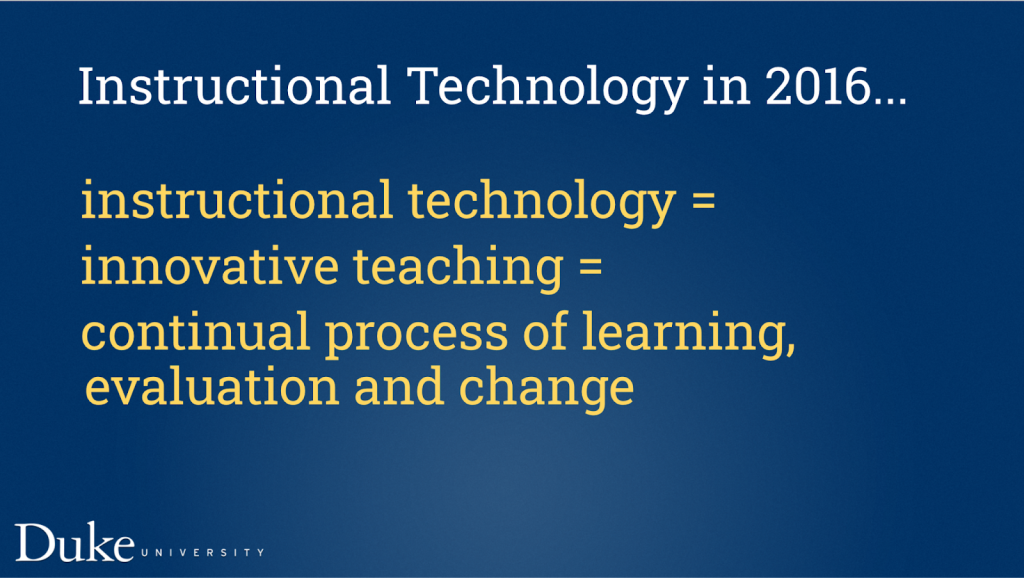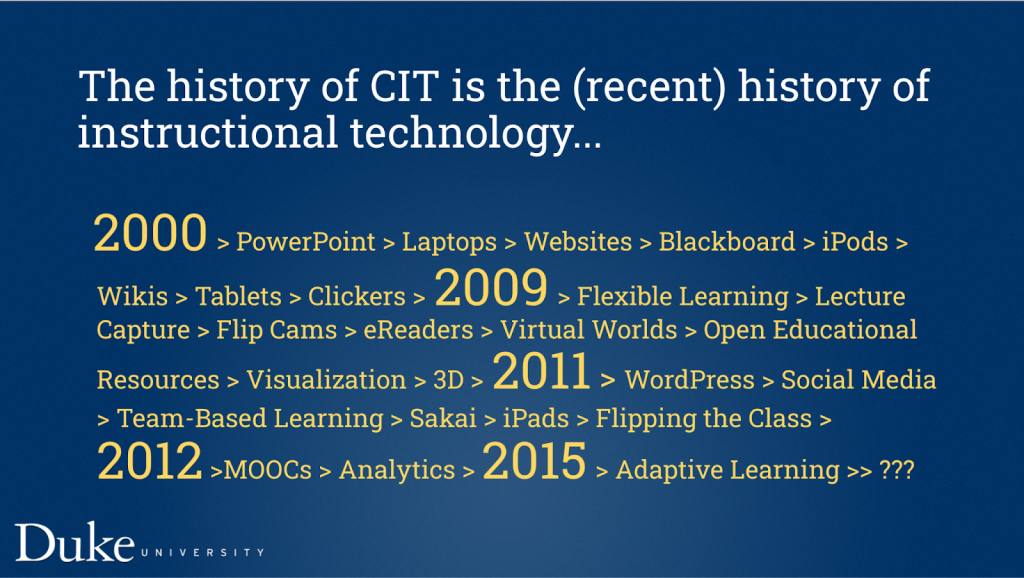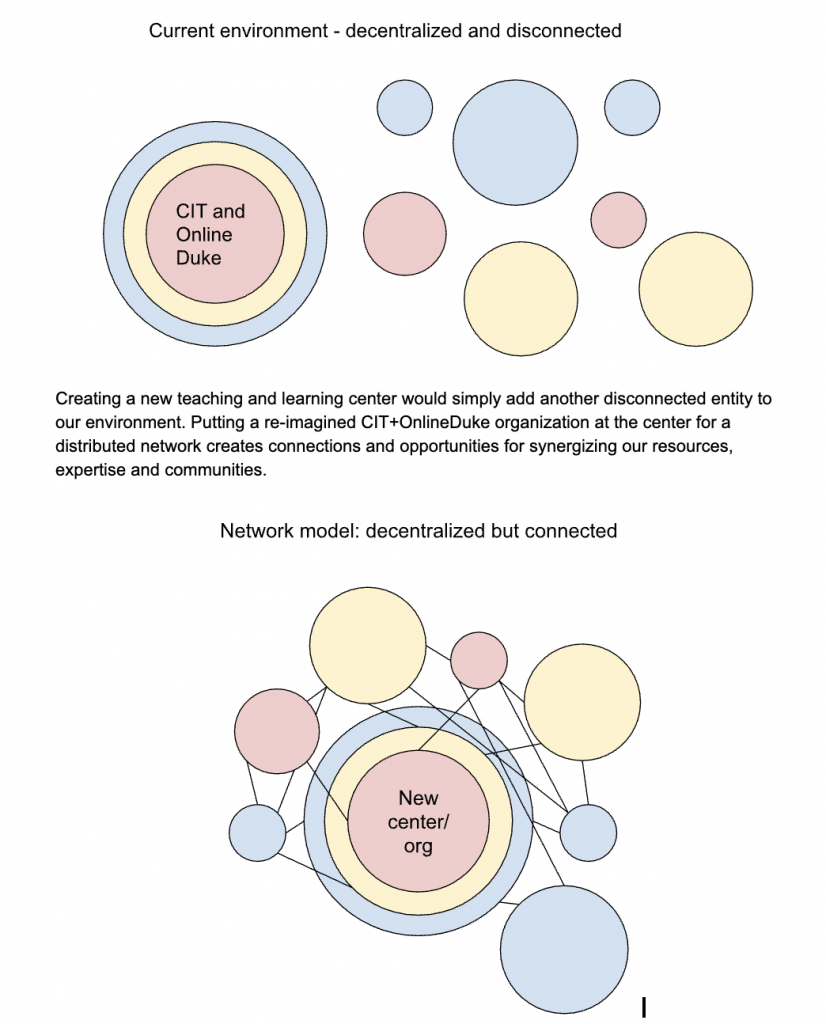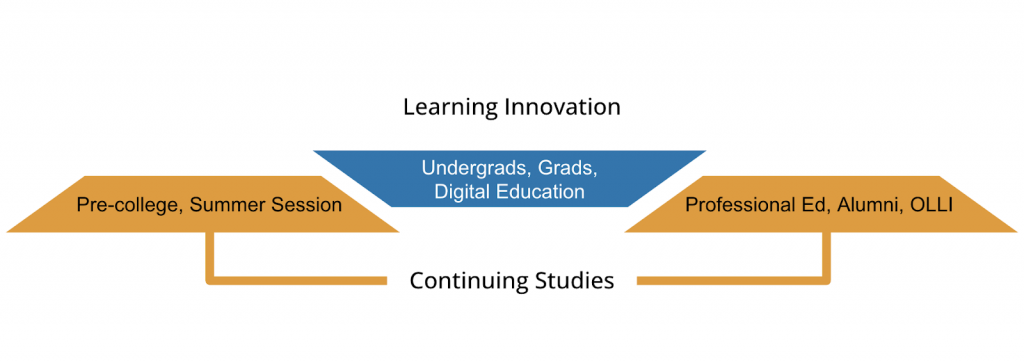Over the past 17 years, I’ve often been asked to tell the story of Learning Innovation at Duke. Versions of that story have ended up on podcasts, in books, annual reports, presentations and more. As I get ready for my next adventure, I’ve been reflecting (as one does) on the experiences and people that have made this journey so worth it, and I think maybe the best way to say goodbye is to tell this story just one more time.
Part 1 – Center for Instructional Technology
I joined Duke’s Center for Instructional Technology in November of 2006. The Duke iPod Project had recently put them ‘on the map’ as both a national driver for digital education and a Duke office that would support faculty and student innovation in teaching and learning. Led by Lynne O’Brien, CIT was composed of a handful of ‘academic technology consultants’ and other instructional technologists. What most of us had in common was varied experience and formal or informal expertise in pedagogy, digital learning technologies and online learning.

During this time, a few critical projects changed the trajectory of my career and the Center:
- Active and flexible learning: Advances and interest in team-based and active learning suggested that Duke needed more classroom spaces that could be quickly rearranged and accommodate different approaches better than standard lecture halls. Duke’s Link opened in 2008 (still in the subfloor of Perkins Library), marking a long-term collaboration between Trinity, Duke Libraries, OIT and CIT to offer and sustain flexible learning spaces. The Link became renowned as an example of such spaces, and to this day is still a tour stop for other universities looking to create similar spaces.
- Blogs as a teaching and learning strategy: Leveraging CIT’s ongoing partnership with the Office of Information Technology (formalized in the Duke Digital Initiative), we launched Duke’s first web-publishing platform. Taking our cues from early experiments at the University Mary Washington, we focused this effort first on teaching and learning. While sites@duke has gone on to become a widely used tool to support all sorts of Duke activities, the original kernel of innovation came from a desire to impact teaching and learning: to help students contribute to public or shared scholarship, to encourage new kinds of digital writing and creation, to create collaborative opportunities for Duke courses.
- Building our learning technology ecosystem: In 2011, Duke began to transition off of Blackboard and moved to Sakai, a community-sourced learning management system that allowed vast amounts of customization and quickly set a precedent for a more engaged, collaborative approach to managing and growing Duke’s learning technology ecosystem.
Part 2 – CIT + Online Duke
In 2012, Duke joined Coursera and quickly made plans to launch 8 massive open online courses (MOOCs) on the platform. After a successful initial launch (visit the DUL archives to review the many reports that came out of this period), we began to grow an online learning team. What started as an intensive year-long series of projects grew an entirely new team we called ‘Online Duke.’
In 2013 I became director of CIT. Here’s a few slides that demonstrate the way I communicated these changes and shifts for the broader Duke community:



Part 3 – Learning Innovation
In 2017, alongside my friend and former colleague Matthew Rascoff, we designed and launched Duke Learning Innovation. The creation and growth of Learning Innovation represents the full evolution and realization of the work our team put into maturing the former Center for Instructional Technology and the Online Duke initiative.
As details and discussions were coming together for provost Sally Kornbluth’s strategic plan ‘Together Duke,’ a recurring question came up: Did Duke need a teaching and learning center? Here’s the way we answered that question:

The strategic plan was updated to reimagine CIT as a truly integrated center, bringing the best in learning science, innovative teaching practices, learning technologies and online learning and design together into one new unit. We called the new unit Learning Innovation, to put a focus back on learning and ultimately the impacts we made on learners. Over a series of meetings and discussions, we wrote a new mission, goals and set of shared values. I’m most proud of our guiding principles, which would time and again serve as a strategic guide and touchstone to so many difficult decisions in the future:
Guiding Principles
- Learning is fundamental to the human experience. We support approaches and technologies that maximize learning through open, equitable and inclusive engagement, collaboration and relationships.
- Evidence-based practices and research are the basis of our work. We assist faculty in applying and advancing the art and science of teaching and learning.
- We are open. We share what we know and do, and help faculty share their knowledge, content and teaching practices. We invest in open technologies and resources to encourage collaborative solutions to shared challenges.
- Diversity, equity, accessibility and inclusion are essential to building a more just and equitable community of learning and society, and we affirm our responsibility to address systems and structures of privilege within and beyond the Duke community.
- We support Duke’s strategic initiatives and goals and seek a long-term impact on the whole Duke community.
- Change happens in networks and collaborative communities of practice. We are a hub to gather and organize alliances university-wide and beyond.
A few key projects and initiatives during this time included:
- NextED Fest: As we established Learning Innovation, we re-envisioned the CIT Showcase (CIT’s annual hallmark event – see a few reports here and a keynote here) as a new ‘festival’ of events, talks and activities, we called ‘NextEd Fest.’ We ran a month of NextEd Fest in 2017 and followed again in 2018 with a series of thematic weeks.
- Bass Digital Education Fellows: In partnership with the Duke Graduate School, we launched a year-long fellowship program to provide Duke PhD students with professional development opportunities to collaborate on leading-edge projects in partnership with Duke faculty and Learning Innovation. The program helped grad students develop new skills to distinguish themselves in the academic job market and to explore emerging career paths in ed tech and teaching and learning innovation.
- Duke Kunshan Learning Innovation Fellows: The first semester of the undergraduate degree programs at Duke Kunshan University began in Fall 2018. Learning Innovation, together with the Duke Kunshan Programs Office and Duke Kunshan’s Dean of Curriculum and Faculty Development, created a six-month faculty development program called the Learning Innovation Fellows for the first cohort of 22 Duke Kunshan undergraduate faculty. This program became an annual event for all new and incoming Duke Kunshan faculty, supported by our extended family at DKU’s Center for Teaching and Learning.
Part 4 – Pandemic
I’m not going to recount the massive pandemic response and Flexible Teaching effort here. That’s been documented in many places now, include an impact report, a study by Ithaka SR, a post I wrote for our annual report and the write up from the Duke Presidential Awards.
With the heroic and exhausting efforts of all involved – not just Learning Innovation, but so many Duke faculty, staff and students – it might be hard to remember that during this period, we also had just enough ‘gas in the tank’ to push things a bit further. My friend and former colleague Kim Manturuk devised the Pandemic Pedagogy Research Symposium to engage a broad range of academics in the discussion and sharing of new and emerging teaching and learning practices developed during the pandemic.
In order to sustain the digital learning innovations that arose during the COVID-19 pandemic, we launched Carry the Innovation Forward. Learning Innovation provided staff support and funding for 29 selected proposals that focused on innovative learning research, new learning technology exploration, re-envisioning a course or program for flexible or online learning, or faculty learning communities.
Part 5 – The Future
After 10 years of our Coursera partnership, we recently hit a milestone: 10 Million enrollments. Millions of learners have experienced a slice (however small) of a Duke education. It’s true that Learning Innovation at Duke has been about impacting our students and faculty — but much of our work has also impacted a much broader world of learners.
The future is hybrid and the future is lifelong learning. Our current Duke students need our help now to become lifelong learners that can pivot to any new career or global shakeup. Our alums want to be able to come back to their trusted institution, and want to draw on the investment they’ve made in this community. Learners in our region and the world want to engage with Duke. Coming out of the pandemic, the time is right for Learning Innovation’s next evolution: combining with Duke Continuing Studies to serve the entire spectrum of learners.

My friend and now former colleague Yakut Gazi summed up this vision beautifully in her blog post celebrating the first 5 years of Learning Innovation as a brand at Duke. Under her leadership, Learning Innovation and Continuing Studies will continue to write this story.
